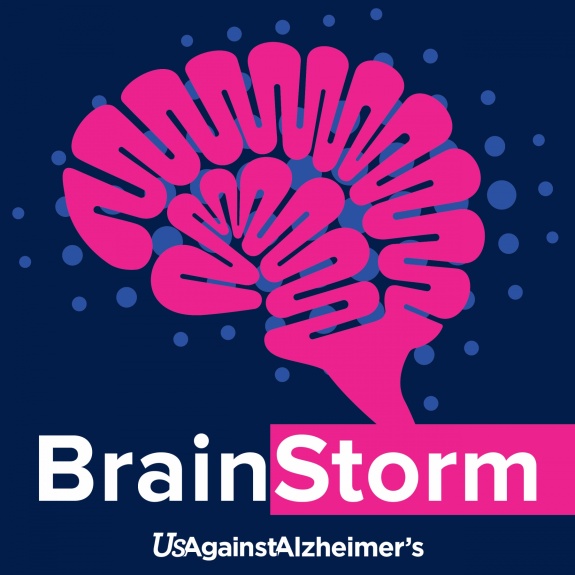Subscribe on your favorite player
Listen on Apple Podcasts Listen on Spotify Listen on Stitcher Listen on Google PodcastsResearch & Advocacy Leaders: Health Equity During COVID-19

About This Episode
COVID-19 has heavily impacted communities of color, making health inequities even worse.
This BrainStorm webcast was the second in a series on health equity challenges created by COVID-19 in the dementia community and beyond. Our host, Meryl Comer, spoke with an expert panel of research organizations about what they are doing to prioritize health equity in their COVID-19 research programs and why diversity matters in brain health research. We also shared results from our latest A-LIST survey on the pandemic's effects on the Alzheimer's community.
Our guest speakers were Phyllis Ferrell of Eli Lilly; Dr. Jaime Perales of Kansas University’s Alzheimer’s Disease Center; Gerren Wilson of Genentech; Kevin Kimble of the Health Equity Collaborative, of which UsAgainstAlzheimer’s is a member; and Jason Resendez of our LatinosAgainstAlzheimer’s Coalition. We also heard from caregiver-advocate Daisy Duarte and former U.S. Surgeon General Dr. David Satcher.
Press the 'Play' button at left to hear the conversation.
While this discussion focused on Latino and African American communities, we recognize that American Indian and Alaska Native people are also being hard-hit by COVID-19. We thank the International Association for Indigenous Aging and our partner the Diverse Elders Coalition for their critical work to address COVID-19 in these communities.
Including Communities of Color in Research
To begin the discussion, former Surgeon Generalwe heard from Dr. David Satcher spoke abouton how disparities impact efforts to fight Alzheimer’s: “We now know there is a major prevention aspect to Alzheimer’s, but we also know there are major disparities in opportunities to prevent it.” HeDr. Satcher cited poor access to good nutrition, quality education and safe places for physical activity—all of which reduce Alzheimer’s risk.
Jason Resendez of LatinosAgainstAlzheimer’s agreed, saying:. “The level of health care infrastructure in this country that serves communities of color and low-income, less educated communities is really deplorable. ,” he said. “It’s one of the reasons why we’re worried in the Alzheimer’s community that, when a treatment is developed, it might require infusion-based delivery, for example, or PET scans. The infrastructure required for those procedures exists in places where income levels are higher and the demographics are more homogenous. But it doesn’t exist in a lot of the lower-income, more diverse communities.”
Phyllis Ferrell observed that successful models of minority participation in research exist, but not in Alzheimer’s. Of Eli Lilly’s research, she said, “We do a better job in diabetes studies, for instance—in therapeutic areas that are more mature. In neuroscience overall, we’re running around 18 percent [minority participation]. In Alzheimer’s disease, that drops to just four or five percent.”
She added, “Right now, it’s either the study runs fast or we do a good job on diversity in recruiting. That can’t be an ‘or’ anymore.”
Dr. Perales of the University of Kansas said, “Having minorities not participate in research widens disparities basically because research means progress. Any progress being found in these studies might not apply to this group that’s excluded from the study.” ParticipationHe added that participation in Alzheimer’s research “is what’s going to get us a cure,” he added..”
Speaking aboutOn the challenges in making research inclusive, Kevin Kimble said, “It’s almost impossible to have inclusion generically. If you don’t say ‘15% of your research population must be African American,’ if left to its own devices, inclusion almost never happens.”
Gerren Wilson said the COVID-19 pandemic has accelerated Genentech’s efforts to bring clinical trials closer to patients. In communities of color, partnerships are essential in this regard, but that approach is not without challenges. “There is some misperception about what capacity exists in safety-net hospitals, and that creates a bias that a lot of industry partners and folks within clinical research operations anchor to, that prevents us from using some of those hospitals,” Wilson said. “. Those hospitals do have advanced diagnostics and well-trained staff.”
Resendez commented, “When you’re not selecting safety-net hospitals, when you’re not selecting community federally-qualified health centers, this is modern-day redlining in health care.”
Research During COVID-19
Dr. Perales described the impact of COVID-19 pandemic has made minority recruitment even harder for on his Alzheimer’s research. “We already had trouble engaging and recruiting minorities,” Dr. Perales said. “. Now with COVID-19, it’s a lot harder. Around 80 percent of our assessments for Alzheimer’s were done at senior centers. That’s no longer possible because the centers are closed, and it’s really hard to contact these communities.” His team has had one study interrupted due to COVID-19: “I’m not sure when it’s going to resume. It was a pilot study, conducting memory screening on African Americans in churches. As you can imagine, that’s not feasible right now.”
Eli Lilly recently launched a COVID-19 study, Phyllis Ferrell said, that “borrowed some ideas from Alzheimer’s disease. We are doing some prophylactic studies in long-term care facilities, and we have a mobile test site, which we’ve done in Alzheimer’s disease. We’re taking these mobile sites—they’re big campers—to bring the testing to the participants.”
Genentech is currently conducting a COVID-19 study focused on communities of color. Wilson said, “Recognizing the disparities in both prevalence and outcomes—the mortality of this pandemic—we invested in a trial specifically targeting and focused on enrolling underrepresented patient communities—communities of color—working with trial sites in communities that have access to these patients and have their trust. There’s a lot we’re learning.”
Dementia Caregiving During COVID-19
Comer shared top-level results from the fifth UsAgainstAlzheimer’s A-LIST survey tracking the pandemic over time:. She said, “Patients are reporting problems with memory. The severe stress levels for caregivers—it’s up around 80% across these surveys for the caregivers, to the point that it impacts their ability to care for their loved ones.”
Daisy Duarte is an advocate and clinical trial participant who has cared for her mother for roughly 10 years. Of the pandemic, she said, “It’s made me paranoid. Every time I go in my mom’s room, I’m wearing gloves and spraying Lysol, making sure she doesn’t get it. I’ve worked so hard to keep her at ease, with Alzheimer’s, to see her go with a virus like this, would devastate me.”
UsAgainstAlzheimer’s is excited to continue to work with Dr. Satcher as part of the new Center for Brain Health Equity, which is supported by the Centers for Disease Control and Prevention's Healthy Brain Initiative. The award is meant to support populations with a high burden of dementia, to develop and implement public health strategies guided by the CDC's Healthy Brain Initiative Road Map.
Support for this BrainStorm was generously provided by PhRMA (Pharmaceutical Research and Manufacturers of America).
Daisy Duarte’s reflections are part of UsAgainstAlzheimer’s new series, “Giving Voice to What Matters Most,” made possible by the support of Shawn Taylor and the KPB Corporation.
